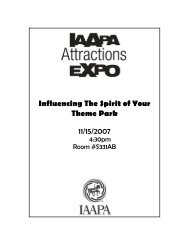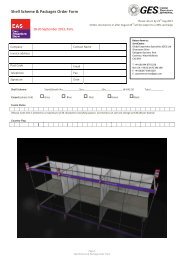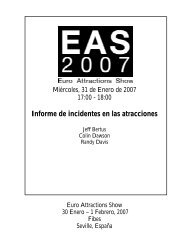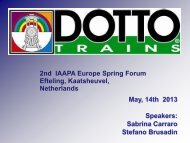Current Trends in Amusement Industry Biomechanics (Size ... - IAAPA
Current Trends in Amusement Industry Biomechanics (Size ... - IAAPA
Current Trends in Amusement Industry Biomechanics (Size ... - IAAPA
Create successful ePaper yourself
Turn your PDF publications into a flip-book with our unique Google optimized e-Paper software.
<strong>Current</strong> <strong>Trends</strong> <strong>in</strong> <strong>Amusement</strong><br />
<strong>Industry</strong> <strong>Biomechanics</strong><br />
Thursday, November 16, 2006<br />
4:30 PM to 5:45 PM<br />
Room # B409
<strong>Current</strong> <strong>Trends</strong> <strong>in</strong> <strong>Amusement</strong> <strong>Industry</strong> <strong>Biomechanics</strong>:<br />
Introduction to <strong>Biomechanics</strong> and Rider K<strong>in</strong>ematics<br />
Exponent<br />
Robert S. Cargill II, Ph.D., P.E.<br />
Irv<strong>in</strong>g Scher, Ph.D., P.E.<br />
William Bussone, M.S.<br />
Michelle F. Heller, Ph.D.<br />
2006 <strong>IAAPA</strong> Attractions Expo Education Programs
Exponent has worked <strong>in</strong> the amusement <strong>in</strong>dustry <strong>in</strong> a variety of areas, <strong>in</strong>clud<strong>in</strong>g thermal<br />
eng<strong>in</strong>eer<strong>in</strong>g, civil eng<strong>in</strong>eer<strong>in</strong>g, biomechanics, and human factors. In a sem<strong>in</strong>ar focus<strong>in</strong>g<br />
on biomechanics, we will present the relevant current research <strong>in</strong> biomechanics, as it<br />
applies to the amusement <strong>in</strong>dustry. Specifically, we will address new data and current<br />
research <strong>in</strong> the areas of human tolerance; ride vehicle accelerations; rider accelerations,<br />
<strong>in</strong>clud<strong>in</strong>g both l<strong>in</strong>ear and angular accelerations; spectral analysis; and jerk (the rate of<br />
change of acceleration). We will put these <strong>in</strong> the context of forces and accelerations seen<br />
<strong>in</strong> daily events and vigorous activities. Our primary focus is head tolerance and daily<br />
exposure, although neck and general body tolerance will also be discussed.<br />
We will also touch on the differences between impact accelerations and <strong>in</strong>ertial<br />
accelerations and their ramifications. Basic background <strong>in</strong>formation will be presented<br />
before progress<strong>in</strong>g through the current data and each area will be discussed as it applies<br />
to the amusement <strong>in</strong>dustry.<br />
This sem<strong>in</strong>ar is <strong>in</strong>tended for an <strong>in</strong>termediate audience, one with a basic knowledge of<br />
physics, <strong>in</strong>clud<strong>in</strong>g acceleration. We will review the appropriate human anatomy as the<br />
need arises. The goal is to provide the audience with a broad overview of the<br />
biomechanical issues currently fac<strong>in</strong>g the amusement <strong>in</strong>dustry and a summary of the<br />
exist<strong>in</strong>g research and capabilities <strong>in</strong> this field.<br />
The follow<strong>in</strong>g topics will be covered:<br />
• Human tolerance, focus<strong>in</strong>g on l<strong>in</strong>ear and angular acceleration tolerance of the<br />
head<br />
• Difference between ride and rider dynamics<br />
• Spectral analysis of on-ride and daily event accelerations<br />
• Magnitude of jerk (rate of change of acceleration) seen <strong>in</strong> daily events<br />
2
K<strong>in</strong>ematic Relationships <strong>in</strong> One Dimension (1-D)<br />
A block is accelerated to the right and moves at constant velocity. A larger, leftward<br />
acceleration reverses the direction of travel and the block moves at a larger velocity to the<br />
left. The block is then exposed to an even<br />
larger, rightward acceleration that br<strong>in</strong>gs it to<br />
an abrupt stop. Figure 1 shows the graphic<br />
relationships between the position<br />
(displacement), velocity (rate of change of<br />
displacement), acceleration (rate of change of<br />
velocity), and the jerk (rate of change of<br />
acceleration).<br />
There are correspond<strong>in</strong>g relations for each of<br />
the three coord<strong>in</strong>ate axes as well as for<br />
rotations about each of the three axes (angle of<br />
rotation, rate of change of angle, rate of change<br />
of angular velocity, etc.).<br />
Vectors<br />
A vector has magnitude and direction and can<br />
be used to describe position, velocity,<br />
acceleration, and jerk. L<strong>in</strong>ear measures <strong>in</strong><br />
three axes can be added vectorially and<br />
produce a resultant vector. Vectors that are at<br />
right angles to each other are orthogonal. For<br />
example, <strong>in</strong> two dimensions, if you move your<br />
body one foot forward and one foot to the left,<br />
you are only 1.4 feet from where you started.<br />
Non-orthogonal vectors can also be added as<br />
shown <strong>in</strong> Figure 2.<br />
Figure 1<br />
3
Figure 2<br />
Angular motion can be characterized by pseudovectors. Angular velocity, acceleration,<br />
and jerk have both magnitude and direction. The effect of these angular motions on<br />
l<strong>in</strong>ear motions is often broken down <strong>in</strong>to its tangential and normal (directed towards the<br />
center of rotation) components. The example <strong>in</strong> Figure 3 illustrates a v<strong>in</strong>yl record rotat<strong>in</strong>g<br />
at a constant rate. In this <strong>in</strong>stance, the angular position is constantly chang<strong>in</strong>g, the angular<br />
velocity is a constant, and the angular acceleration and jerk are zero. It is <strong>in</strong>terest<strong>in</strong>g to<br />
note that even as the whole object rotates at a constant angular velocity, at any given<br />
location on the record, the magnitude of the l<strong>in</strong>ear velocity is constant, but the direction is<br />
constantly chang<strong>in</strong>g due to the rotation. The constantly chang<strong>in</strong>g direction causes each<br />
po<strong>in</strong>t to experience a l<strong>in</strong>ear acceleration directed towards the center of the rotation of the<br />
record. The magnitude of this normal acceleration vector becomes larger as the distance<br />
from the center becomes greater.<br />
Figure 3<br />
4
Axes<br />
A body can move and be moved <strong>in</strong> three orthogonal l<strong>in</strong>ear directions, which are<br />
commonly referred to as x, y, and z. The def<strong>in</strong>ition of the axes can vary, but generally<br />
one axis is fore-aft, one is up-down, and one is left-right, relative to the body. The name<br />
of each axis can be arbitrarily assigned, but needs to be well def<strong>in</strong>ed and rema<strong>in</strong><br />
consistent throughout an analysis. The axis names are also dependent on context and the<br />
body configuration (i.e. sitt<strong>in</strong>g or stand<strong>in</strong>g). For <strong>in</strong>stance, the “up” direction for the leg of<br />
a sitt<strong>in</strong>g rider is different than the “up” direction of the leg of a stand<strong>in</strong>g rider. The<br />
standard coord<strong>in</strong>ate system for amusement rides is depicted <strong>in</strong> Figure 4, as def<strong>in</strong>ed by<br />
ASTM F 2137.<br />
The body’s tolerance to acceleration is not the same for all axes, referred to as axis<br />
sensitivity. For example, the body’s tolerance to accelerations across the body (forward<br />
or rearward) is higher than its tolerance to accelerations <strong>in</strong> the axial direction (upward or<br />
downward). Additionally, the body also has different tolerances depend<strong>in</strong>g on the<br />
direction of the force along the same axis, known as sign sensitivity. For example,<br />
humans can tolerate larger forward accelerations of the body than rearward accelerations.<br />
As a result of this knowledge, astronauts are positioned dur<strong>in</strong>g takeoff so that the largest<br />
acceleration components act <strong>in</strong> the direction to which they have the highest tolerance.<br />
The body is also sensitive to rotation and the rotational axes. Based on the coord<strong>in</strong>ate<br />
system shown <strong>in</strong> Figure 4, rotations about the x-axis at the hips are called roll, rotations<br />
about the y-axis are called pitch, and rotations about the z-axis are called yaw. The body<br />
responds differently to each of these rotations and is sensitive to the sign of pitch. As for<br />
l<strong>in</strong>ear axes, rotational axes are arbitrary and context-sensitive. Before any analysis, the<br />
rotational axes need to be properly def<strong>in</strong>ed.<br />
The vehicle has its own coord<strong>in</strong>ate system that is <strong>in</strong>dependent of the rider’s coord<strong>in</strong>ate<br />
system (Figure 5). These two coord<strong>in</strong>ate systems may be co<strong>in</strong>cident, but usually have a<br />
relative motion between them <strong>in</strong> most real-world applications. Depend<strong>in</strong>g on how the<br />
rider moves, the rider’s z-axis could be po<strong>in</strong>ted <strong>in</strong> the vehicle’s x-direction, or vice-versa.<br />
Also, yaw for the ride, for example, may not <strong>in</strong>dicate a yaw for the rider, depend<strong>in</strong>g on<br />
how the rider is positioned on the ride. It is for these reasons that it is imperative to<br />
properly def<strong>in</strong>e all coord<strong>in</strong>ate systems and be consistent throughout an analysis.<br />
Additionally, due to the compliance of the human body, parts of the body can translate<br />
(move l<strong>in</strong>early) and rotate relative to other parts. As such, it may be desirable under<br />
certa<strong>in</strong> circumstances to designate separate coord<strong>in</strong>ate systems for each body segment.<br />
5
Figure 4<br />
Figure 5<br />
6
Rider Response<br />
For some amusement park rides, the ride vehicle is mov<strong>in</strong>g and rotat<strong>in</strong>g <strong>in</strong> three<br />
dimensions. As described <strong>in</strong> the previous section on vectors, the recorded accelerations of<br />
the vehicle vary depend<strong>in</strong>g on where they are measured. In general, it is not possible to<br />
rigidly attach a rider to a ride vehicle. As a result, the rider typically has some motion<br />
with<strong>in</strong> the conf<strong>in</strong>es of the restra<strong>in</strong>ts. Movement of the rider relative to the vehicle results<br />
<strong>in</strong> rider accelerations that can vary from the ride vehicle accelerations.<br />
A rider can also experience a variety of frequency components simultaneously dur<strong>in</strong>g an<br />
amusement park ride. A simple example of this would be a child’s roller coaster with a<br />
s<strong>in</strong>usoidal track that has a “bumpy wheel” (Figure 6). As shown, the track of the ride<br />
exposes the rider to a low frequency, high amplitude motion and the “bumpy wheel”<br />
exposes the rider to a higher frequency, low amplitude motion. As a result, the rider is<br />
exposed to both of these effects simultaneously dur<strong>in</strong>g the ride. The right column of this<br />
figure illustrates this effect us<strong>in</strong>g a frequency component plot. Any signal can be<br />
analyzed to determ<strong>in</strong>e its frequency content us<strong>in</strong>g the Fourier Transform. More complex<br />
rides have the potential for expos<strong>in</strong>g the rider to different frequency comb<strong>in</strong>ations<br />
throughout the ride.<br />
Figure 6<br />
7
Frequency components can produce both mechanical and biological responses with<strong>in</strong> the<br />
human rider. An occupant’s body can dissipate mechanical energy by virtue of the<br />
viscoelastic nature of soft tissues: The body itself acts as a low pass filter for higher<br />
frequency signals such as vehicle vibration. As a result, a rider’s head is likely to<br />
experience less amplitude of vibration than would be measured with<strong>in</strong> the ride vehicle or<br />
at the rider’s pelvis. Figure 7 illustrates this concept <strong>in</strong> a simplified mechanical model of<br />
this effect.<br />
Figure 7<br />
Each location <strong>in</strong> the human body is mechanically sensitive to frequencies with<strong>in</strong> a<br />
def<strong>in</strong>ed range unique to that location. Figure 8 presents a simplified mechanical model of<br />
the human body response to vertical mechanical acceleration.<br />
8
Figure 8 – From Chaff<strong>in</strong> et al., 1999<br />
Adapted from Rasmussen, 1982, and von Gierke et al., 1975<br />
Additionally, mechanical stimuli can directly and <strong>in</strong>directly affect the biology of the<br />
human body. The biological response has been shown to be frequency-dependent.<br />
Natural frequencies occur with<strong>in</strong> the body such as postural sway and peristalsis (the<br />
undulations <strong>in</strong> the gastro<strong>in</strong>test<strong>in</strong>al tract to move food dur<strong>in</strong>g digestion.) Mechanical<br />
sources that <strong>in</strong>troduce external frequencies <strong>in</strong>to the system can cause different biological<br />
effects with<strong>in</strong> each body system or components of a body system such as those shown <strong>in</strong><br />
Figure 9.<br />
9
Figure 9 – Adapted from Chaff<strong>in</strong> et al., 1999, and Rasmussen, 1982<br />
The human body is a complex, <strong>in</strong>terl<strong>in</strong>ked mechanical system that conta<strong>in</strong>s actuators<br />
(muscles) and a complex control system (nervous system). In response to a sudden<br />
mechanical <strong>in</strong>put, the control system response takes time to develop. In the <strong>in</strong>terim, the<br />
human body responds passively from its current state. For example, dur<strong>in</strong>g a rapid lateral<br />
seat translation, the unrestra<strong>in</strong>ed human head is likely to stay <strong>in</strong> a relatively constant<br />
position and orientation until the passive stiffness of the body l<strong>in</strong>kages translates force to<br />
10
the level of the head. This phenomenon is illustrated <strong>in</strong> the bumper car rider shown <strong>in</strong><br />
Figure 10.<br />
Figure 10<br />
Depend<strong>in</strong>g on the geometry of the vehicle and a person’s ability to react to sudden<br />
movements, a sudden acceleration could result <strong>in</strong> a rider contact<strong>in</strong>g part of the vehicle<br />
with their head or another body part. For this reason, ASTM F 2291 requires that<br />
padd<strong>in</strong>g be considered and amusement rides are typically padded where contact may<br />
occur. The relative distance, acceleration direction and magnitude, and reaction time<br />
play a role <strong>in</strong> determ<strong>in</strong><strong>in</strong>g the severity of the contact or if a contact occurs at all. Figure<br />
11 shows typical head and trunk movements caused by sideways and front-to-back<br />
accelerations as observed by Vibert and colleagues (2006). The values below each<br />
schematic draw<strong>in</strong>g are the average values (± Standard deviation) for 108 subjects. In the<br />
figure, LTM is the latency of the <strong>in</strong>itial trunk movement <strong>in</strong> space, LHM is the latency of<br />
the <strong>in</strong>itial head movement <strong>in</strong> space, LPHT is the latency to the peak of the <strong>in</strong>itial head<br />
translation <strong>in</strong> the direction opposite to the sled, and LPHR is the latency to the peak of the<br />
<strong>in</strong>itial head roll.<br />
11
Figure 11 – From Vibert et al., 2006<br />
Human response to a given stimulus, such as a ride’s acceleration, generally demonstrates<br />
a range of responses that fall with<strong>in</strong> a predictable envelope. Specific rider acceleration<br />
and motion <strong>in</strong> response to a given ride acceleration will depend on the rider and their<br />
state at a given <strong>in</strong>stant. Their <strong>in</strong>dividual characteristics determ<strong>in</strong>e where <strong>in</strong> the human<br />
range they will fall. Because of this, the rider response envelope must be modeled or<br />
measured. Ride measurements cannot account for rider action or rider response, such as<br />
contact with the restra<strong>in</strong>ts or with another rider, without an understand<strong>in</strong>g of the rider<br />
response envelope. For example, test<strong>in</strong>g on amusement bumper cars <strong>in</strong>dicates that rider<br />
head acceleration can vary <strong>in</strong> magnitude from the vehicle acceleration.<br />
12
Human Tolerance and Everyday Events<br />
Humans can, and do, tolerate l<strong>in</strong>ear head accelerations exceed<strong>in</strong>g 100G 1 and angular head<br />
accelerations exceed<strong>in</strong>g 10,000 rad/s 2 . The average non-<strong>in</strong>jurious head impact <strong>in</strong> a<br />
Division I collegiate football practice or game is 32G, with a maximum recorded value of<br />
200G. The <strong>in</strong>jury assessment reference value for side impacts is 180G for a 50 th<br />
percentile adult male. Most current head <strong>in</strong>jury research focuses on acceleration tolerance<br />
of the bra<strong>in</strong>.<br />
Much research is done on the 50 th percentile adult male. Due to the cont<strong>in</strong>uum of age,<br />
weight, height, and differences <strong>in</strong> gender, the tolerances of other members of the<br />
population may vary from these standard values. To estimate values for these<br />
populations, various scal<strong>in</strong>g techniques have been applied. A method to assess subtolerance,<br />
normal exposure for a wide segment of the population is to document the<br />
accelerations associated with everyday events.<br />
Research on everyday events has found that the daily exposure to l<strong>in</strong>ear and angular<br />
accelerations for people aged 20 to 50 years old is up to approximately 10G and 1000<br />
rad/s 2 . These accelerations typically last for approximately 0.15 seconds and are not<br />
<strong>in</strong>fluenced by height, weight, age, or handedness. Some studies have found that males<br />
demonstrate slightly larger accelerations, whereas others have found that the difference<br />
due to gender is negligible. The accelerations found <strong>in</strong> everyday events are far below<br />
reported <strong>in</strong>jury thresholds. For most activities, measured accelerations are higher <strong>in</strong> lower<br />
positions of the sp<strong>in</strong>e.<br />
Everyday Activities<br />
Angular Acceleration (rad/s2)<br />
10000<br />
9000<br />
8000<br />
7000<br />
6000<br />
5000<br />
4000<br />
3000<br />
2000<br />
1000<br />
0<br />
boxers<br />
Roller coaster and everyday activities<br />
0 10 20 30 40 50 60 70 80 90 100<br />
Angular Rate (rad/s)<br />
subdural hematoma<br />
Figure 12 – Roller coaster and everyday activities shown on the same scale as other<br />
tolerance data<br />
1 1G is equivalent <strong>in</strong> magnitude to the acceleration due to gravity: 9.8 m/s 2 (32.2 ft/s 2 ).<br />
13
Figure 12 illustrates the relative magnitudes of the head angular rates and head angular<br />
accelerations associated with roller coaster and everyday activities compared to those<br />
values <strong>in</strong> box<strong>in</strong>g and human tolerance levels. The everyday activities are represented by<br />
the blue and p<strong>in</strong>k curves <strong>in</strong> the lower left corner of the figure.<br />
Everyday events are usually non-contact accelerations. Contact accelerations, such as<br />
be<strong>in</strong>g struck <strong>in</strong> the head with a pillow, tend to be larger <strong>in</strong> magnitude but smaller <strong>in</strong><br />
duration than non-contact accelerations, thus <strong>in</strong>dicat<strong>in</strong>g higher levels of jerk. Examples of<br />
everyday, non-contact peak resultant head acceleration are shown <strong>in</strong> Figure 13.<br />
Figure 13 – From Ng et al., 2006a<br />
The human body is a complex, <strong>in</strong>terl<strong>in</strong>ked mechanical system. As such, the angular and<br />
l<strong>in</strong>ear accelerations of the head are k<strong>in</strong>ematically related. Figure 14 presents the<br />
relationship between the peak angular and l<strong>in</strong>ear head accelerations for volunteers<br />
perform<strong>in</strong>g vigorous activities of daily liv<strong>in</strong>g. For comparison, the s<strong>in</strong>gle axis maximum<br />
acceleration of 6G permitted <strong>in</strong> ASTM F 2291 is shown by a vertical l<strong>in</strong>e on this figure.<br />
Note that for some axes and durations, the maximum acceleration is substantially less<br />
than this value.<br />
14
Peak Resultant L<strong>in</strong>ear Acceleration and Angular Accelerations for Each Subject by Gender<br />
Figure 14 – Adapted from Scher et al., 2005<br />
Spectral analysis, a study of the acceleration frequencies, of everyday events shows that<br />
the accelerations are with<strong>in</strong> the range of 0-5 Hz (cycles per second) and tend to peak at 2<br />
Hz for most activities studied. These results are shown <strong>in</strong> Figures 15 and 16.<br />
Compiled PSD of head acceleration while skipp<strong>in</strong>g rope (30 subjects).<br />
Figure 15 – From Richards et al., 2005<br />
Peak frequency response (mean ± standard error)<br />
Figure 16 – From Richards et al., 2005<br />
15
Bumper Cars<br />
The rotational and l<strong>in</strong>ear head accelerations, as well as neck forces and moments, are<br />
similar between bumper cars and everyday events. For lateral bumper car impacts (sideimpacts),<br />
lateral head accelerations were slightly higher than for everyday events. Results<br />
from other types of amusement rides appear to be similar. Ride accelerations are<br />
comparable to everyday accelerations such as those shown <strong>in</strong> Figure 17.<br />
Figure 17 – From Vijayakumar et al., 2006<br />
16
Bibliography<br />
Allen ME, Weir-Jones I, Motiuk DR, Flew<strong>in</strong> KR, Gor<strong>in</strong>g RD, Kobetitch R, and<br />
Broadhurst A. (1994) “Acceleration perturbations of daily liv<strong>in</strong>g.” Sp<strong>in</strong>e; 19(1):<br />
1285-1290.<br />
Arndt SR, Cargill RS, and Hammoud S. (2004) “Head accelerations experienced dur<strong>in</strong>g<br />
everyday activities and while rid<strong>in</strong>g roller coasters.” Proceed<strong>in</strong>gs of the Human<br />
Factors and Ergonomics Society; 48: 1973-1977.<br />
ASTM. (2004) “Standard practice for measur<strong>in</strong>g the dynamic characteristics of<br />
amusement rides and devices.” F 2137-04.<br />
ASTM. (2006) “Standard practice for design of amusement rides and devices.” F 2291-<br />
06a.<br />
Chaff<strong>in</strong> DB, Andersson GBJ, and Mart<strong>in</strong> BJ. (1999) Occupational <strong>Biomechanics</strong>. New<br />
York, NY: John Wiley & Sons, Inc.<br />
Duma SM, Manoogian SJ, Bussone WR, Brol<strong>in</strong>son PG, Goforth MW, Donnenwerth JJ,<br />
Greenwald RM, Chu JJ, and Crisco JJ. (2005) “Analysis of real-time head<br />
accelerations <strong>in</strong> collegiate football players.” Cl<strong>in</strong> J Sports Med; 15: 3-8.<br />
Exponent Failure Analysis Associates. (2002) “Investigation of amusement park and<br />
roller coaster <strong>in</strong>jury likelihood and severity.” Report prepared for Six Flags.<br />
DC18967.000 A0T0 0802 FR01.<br />
McElhaney JH, Roberts VL, Hilyard JF, and Kenkyujo NJ. (1976) Handbook of Human<br />
Tolerance. Japan Automobile Research Institute, Inc. (JARI).<br />
National Safety Council. (2003) “Injury <strong>in</strong>sights”. June/July 2003.<br />
Ng TP, Bussone WR, and Duma SM. (2006a) “The effect of gender and body size on<br />
l<strong>in</strong>ear accelerations of the head observed dur<strong>in</strong>g daily activities.” Biomed Sci<br />
Instrum; 42: 25-30.<br />
Ng TP, Bussone WR, Duma SM, and Kress TA. (2006b) “Thoracic and lumbar sp<strong>in</strong>e<br />
accelerations <strong>in</strong> everyday activities.” Biomed Sci Instrum; 42: 410-415.<br />
Rasmussen, G. (1982) “Human body vibration exposure and its measurement.”<br />
Technical Review, Bruel & Kjaer; 1: 3-31.<br />
Richards D, Scher I, Vijayakumar V, Carhart M, Larson R, Taylor S, and Corrigan CF.<br />
(2005) “Repetitive head load<strong>in</strong>g: accelerations dur<strong>in</strong>g cyclic, everyday activities.”<br />
ISB XXth Congress – ASB 29 th Annual Meet<strong>in</strong>g, July 21- Aug 5, Cleveland, OH.<br />
17
Scher I, Richards D, Vijayakumar V, Carhart M, Corrigan CF, and Jaekel D. (2005)<br />
“Coronal head accelerations dur<strong>in</strong>g vigorous activities of daily liv<strong>in</strong>g.” 2005 Summer<br />
Bioeng<strong>in</strong>eer<strong>in</strong>g Conference, June 22-26, Vail, CO.<br />
Smith DH and Meaney DF. (2002) “Roller coasters, G forces, and bra<strong>in</strong> trauma: on the<br />
wrong track?” Journal of Neurotrauma; 19(10): 1117-1120.<br />
Vibert N, Hoang T, Gilchrist DPD, MacDougall HG, Burgess AM, Roberts RD, Vidal<br />
PP, and Curthoys IS. (2006) “Psychophysiological correlates of the <strong>in</strong>ter-<strong>in</strong>dividual<br />
variability of head movement control <strong>in</strong> seated humans.” Gait & Posture; 23: 355-<br />
363.<br />
Vijayakumar V, Scher I, Gloeckner DC, Pierce J, Bove R, Young D, and Cargill R.<br />
(2006) “Head k<strong>in</strong>ematics and upper neck load<strong>in</strong>g dur<strong>in</strong>g simulated low-speed rearend<br />
collisions: a comparison with vigorous activities of daily liv<strong>in</strong>g.” SAE 2006-01-<br />
0247.<br />
Von Gierke HW, Nixon CW, and Guignard JC. (1975) “Noise and Vibration.” <strong>in</strong> M<br />
Calv<strong>in</strong> and OO Gazenko, Eds., Ecological and Physiological Foundation of Space<br />
Biology and Medic<strong>in</strong>e, Vol. 2, Book 2, NASA, Wash<strong>in</strong>gton, DC: 355-405.<br />
18
Authors and contact <strong>in</strong>formation<br />
Robert S. Cargill II, Ph.D., P.E.<br />
3401 Market Street, Suite 300<br />
Philadelphia, PA 19104<br />
215-594-8833<br />
rcargill@exponent.com<br />
Irv<strong>in</strong>g Scher, Ph.D., P.E.<br />
5401 McConnell Avenue<br />
Los Angeles, CA 90066<br />
310-754-2756<br />
ischer@exponent.com<br />
William Bussone, M.S.<br />
3401 Market Street, Suite 300<br />
Philadelphia, PA 19104<br />
215-594-8894<br />
wbussone@exponent.com<br />
Michelle F. Heller, Ph.D.<br />
3401 Market Street, Suite 300<br />
Philadelphia, PA 19104<br />
215-594-8876<br />
mheller@exponent.com<br />
www.exponent.com<br />
The authors would like to acknowledge the graphical efforts of Michael Drzal,<br />
Multimedia Technician.<br />
Material copyright 2006, Exponent, Inc.<br />
Copy<strong>in</strong>g and reproduction subject to the agreement between Exponent and <strong>IAAPA</strong>, all<br />
other rights reserved by Exponent. Some materials <strong>in</strong>cluded are copyright by their<br />
respective authors.<br />
19
















